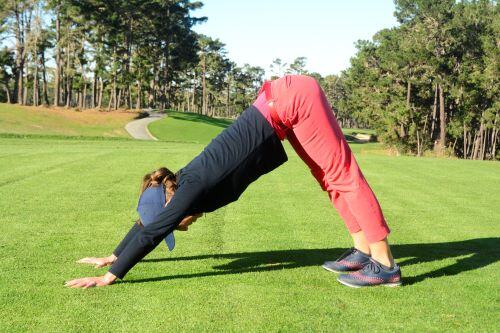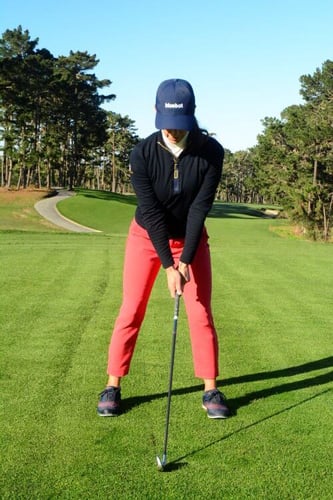
BY AL BARKOW
First Appeared in Spring 2021 Golf Magazine
How is it that the mulligan is so often a much better shot than the one that prompted it? Dodie Mazzuca has an answer: “Because we don’t stand over the ball too long.” Which is to say, with the mulligan we just let ourselves go – no technique thoughts, no tension in the body arising from the situation (I need this one: I want to impress my pals, etc.). Which leads to the conclusion: make your first shot your mulligan – “Play Mulligan Golf,” she says. It’s a mental exercise and another expression of the time-honored dictum that golf is 90% mental: maybe more. It’s at the heart of Mazzuca’s teaching. She came to it through personal experience. “I started playing golf at age seven, but it was when I began to compete seriously, was traveling a lot and playing tournament golf that my stomach began bothering me all the time, along with body tension,” she says. Both of which hampered her performance on the LPGA Tour.
DISCOVERING YOGA
“I went to a doctor who told me I should stop traveling and playing tournament golf,” she says. “This was not an option at the time. I started doing yoga, and my health improved both physically and mentally. The more yoga I did, the better I played. I began to study yoga more and more and eventually, after I stopped playing competitively and began to teach, I realized that so much of the philosophy applies to golf performance.” She also read the books of pioneering sports psychologist Bob Rotella, instructor Fred Shoemaker, who teaches the principles of his Extraordinary Golf at Carmel Valley Ranch, and the spiritual golf philosophizing of NorCal resident Michael Murphy's cult classic Golf in the Kingdom. However, her instruction is not based only on that mental landscape. “Especially now, with so many new golfers coming into the game, it’s very much necessary to instruct the fundamentals of grip, address, position, and so on,” Mazzuca says. “Even experienced golfers need another set of eyes on those basics.”
GRIP PRESSURE
Still, the basics and the overall mechanics of shot making are affected by the mental equation in her teaching. “For example, it tends to produce a lighter grip, which in turn produces better swing tempo. And more power. You’ll arrive at the right pressure personally by milking the club. Squeeze your grip very tight, then loosen it, and eventually you’ll find the pressure that suits you.
Mazzuca advises. “It’s usually somewhere in the middle. There is a term in Sanskrit that translates as steadiness, balance. You want to find the middle of opposites. An immediate situation may demand a little tighter grip, if for instance you have a shot out of thick grass. But the main key, even in this circumstance, is to maintain the same grip pressure throughout the swing.”
RELAX THE LEFT ARM
Mazzuca allows that a yoga approach might also lead to a relaxed left arm in the backswing. “A tight left arm is tension. If it’s too tight everything else goes off kilter. A slight bend can increase the length of your backswing and, in turn, produce a better-timed downswing.” Indeed, the overriding issue in her teaching is tension management. “I always say tension is the No. 1 killer of golf swings. Each person deals with or exhibits tension differently, so I suggest a lot of self-study. When you are under pressure and really need a good shot, you want to know what part of your body tightens. A lot of people feel it in their hands, some in their shoulders, others get too quick in the takeaway. When you know how your body responds you can develop a pre-shot routine that will ease that tension. You can practice it, as well. When hitting shots on the range, find ways to ease tension in your shoulders or jaw; learn to trust a light grip.” The start of the golf swing is very important to making a good shot. It wants an easy pace, which comes out of a yoga-generated attitude at address. “Once the setup is established – your spine is straight, your arms hang pretty much straight down from your body, there is a dynamic flex or bend of the knees, weight is on the balls of your feet, your right elbow is in close to your side, and you have a correct alignment to the target – you take a deep breath and create a one-piece swing,” Mazzuca says. “That is, the arms, the club, and the shoulders all move as one unit, in unison. Some teachers say the swing of the arms should start the action, for others it is a turn of the shoulders or hips, but I believe that the fewer parts moving individually the less that can go wrong. It leads to a one-plane swing; there is no loop or re-routing of the club in the downswing, and it helps achieve good balance and weight shift. “And, it is a counter to the sway, which is a big issue. You sway when your body moves laterally on the backswing. Often, the response is to stay back on your right side in the downswing. Good contact rarely derives from this. “You want to coil your body with your spine angle remaining erect. Your right leg will straighten, but not hyperextend. There has to be some softness, a bit of flex.”
PLAY WITH A CLEAR MIND
Once asked why he stood over a putt as long as he did before making the stroke, Jack Nicklaus replied that he wanted to clear his mind of all thought. In the final analysis, Dodie Mazzuca’s teaching comes to that very notion. “The conclusive evidence through my teaching is that as humans we self-sabotage golf shots by over-conceptualizing and not experiencing them. As the Zen Buddhist scholar Daisetsu Suzuki once said, technical knowledge is not enough. One must transcend techniques so that the art becomes artless and grows out of the unconscious,” she says. “Once we get past the fundamentals, it is best to not have any thought of them when playing. When people are playing well they are not thinking about their swing. You approach every shot by creating it in your mind’s eye. When you already have it in mind you just step up to the ball and do it. In a sense you perform what you’ve already done. Your mind should be cleared when playing each shot.”